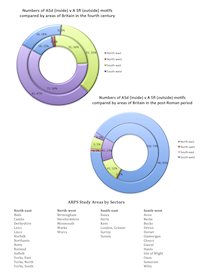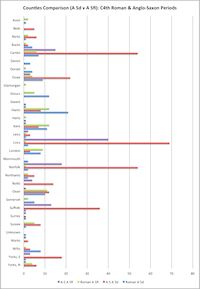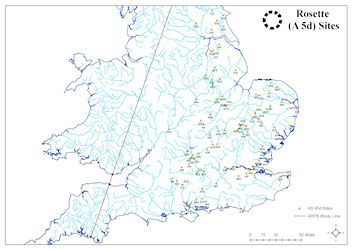
There have been endless arguments over how, why and when the pottery industry of late Roman Britain came to an end. Certainly regional considerations played a more major role than has been admitted until fairly recently and the factors that ended production at Crambeck were almost certainly not those that closed down the New Forest operations. Manufacturing seems to have been winding down in most production centres before AD 400, and there is very little evidence for kiln-firing after about 410. By around 420, use of the slow wheel (or tournette) was abandoned as well, and this is the simplest technology imaginable (Paul Blinkhorn and Dr Catherine Hills both concur on this; pers. comm.). Even in the west of Britain, where the Roman influence appears to have lasted longest, wheel-thrown pottery disappeared. There were some imports of Late Roman C Ware [PRSW] from the Mediterranean (Hayes 1972, 422), but hardly enough to supply an entire region. It is tempting to conclude that the Germanic immigrants must have had some sort of cultural inhibition about how their pottery was produced!
Most of the stamps that I shall be considering in this section come from pots that were either used to contain a cremation or were associated with a cremation or (less often) an inhumation. Stamped pottery is found on 5th-century habitation sites, but generally on single small sherds and in much smaller quantities than in the cemeteries. This is a complete change from find patterns in the 4th century when the vast majority of examples come from cities, towns, villas and other habitation sites. There was also a major change in the type of vessel used as a base. In the 4th century, an open-mouthed bowl was the favoured shape; in the 5th, the favoured shape was a pot with a fairly narrow mouth, spreading out at the waist and tapering in again to the foot. This design has been developed many times in many periods as suitable for storage, and was used as such in the Roman period, but was not then favoured as a base for stamping.
The AASPS has recorded 308 examples of the various A 5d motifs (Variations i-xvi, excluding ii-iv) from 98 sites, which represents about 2.3 per cent of the whole archive. For the A 5fi motif, the AASPS has recorded 96 examples from 29 sites, representing approximately 0.71 per cent of the whole. The contrast in numbers and proportions with the Roman period is striking, but it should be noted that the Roman repertoire of motifs is much smaller than in the Anglo-Saxon period. The classification has identified 765 motifs (although not all have physical examples) from the later period, while by April 2015 I had only identified 238 that the Romans had utilised.

Statistical analysis (Nearest Neighbour Index and Ripley's K, see O'Sullivan and Unwin 2003) demonstrates some clustering of the A 5d motifs, particularly around Cambridge and Lark Valley, and in southern Lincolnshire, although there is an extremely interesting cluster along the Thames in southern Oxfordshire, which crosses the 4th to 5th century divide (Figure 10). Abingdon has produced a Roman example of A 5d from Broad Street (Parrington and Balkwill 1975) and an Anglo-Saxon one from the habitation site at Audlett Drive (Keevil 1992), while less than a mile away in Radley parish, the Barrow Hills Roman cemetery and the adjacent Anglo-Saxon habitation site have produced examples (Chambers and McAdam 2007). The adjoining Barton Court Farm habitation site has produced one Roman example, but none from the Anglo-Saxon period (Miles 1984). Approximately 5 miles to the east, and just north of Dorchester-on-Thames, lies the parish of Berinsfield (Figure 11). The Roman landscape at Wally Corner in that parish has an Anglo-Saxon inhumation cemetery within it (Boyle et al. 1995). Both the Roman landscape and the cemetery have produced an A 5d stamp (Boyle et al. 1995, fig. 11-12 and fig. 75, Grave 104-6).
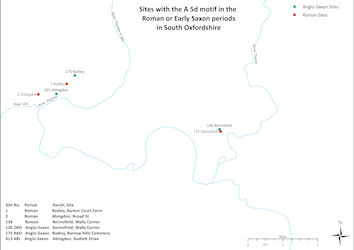
Apart from the south Oxfordshire cluster, there are eight other places where the A 5d motif has shown up in both the Roman and Anglo-Saxon periods (see Table 4).
| Parish | ARPS no./AASPS code | Site | County |
|---|---|---|---|
| Caistor St Edmund | 60 | Town | Norfolk |
| Caistor St Edmund | 019 CAS | Gravel pit opp. Venta Icenorum | Norfolk |
| Cambridge | 63 | Ridgeons Gardens | Cambs |
| Cambridge | 142 SJO | St John's Cricket Field | Cambs |
| Girton | 044 GIR | Cemetery | Cambs |
| Great Chesterford | 455 / 573 | Roman town | Essex |
| Great Chesterford | 041 ESX | Roman town | Essex |
| Heybridge (Maldon) | 192 | Elizabeth Way (1972) | Essex |
| Heybridge (Maldon) | 391 ESX | Hall Road, Chalet Site | Essex |
| Lincoln | 500 | Flaxengate | Lincs |
| Lincoln | 079 LIN | Westwick Gardens Roman kiln | Lincs |
| London EC3 | 249 | Tower of London | London |
| London EC4 | 238 | Cannon Street (Palace) | London |
| London EC | 507 | Site in City (Young 1977) | London |
| Covent Garden | 401 GLC | London Transport Museum | London |
| Milton Keynes | 270 | Caldecotte Lake | Bucks |
| Milton Keynes | 017 MKN | Pennyland | Bucks |
| Portchester | 305 | Castle | Hants |
| Portchester | 234 POR | Castle | Hants |
There are three Roman examples of the A 5d motif from Caistor St Edmund. They come from the 1920s and 1930 excavations within the town and are unpublished (Tim Peston, pers. comm.). There are eight Anglo-Saxon examples from the cremation cemetery which lies about 300 yards east of the south-east corner of the town walls (Myres and Green 1973). The A 5fi motif was also found there (see below).
Ridgeon Gardens in Cambridge lies about half a mile from the St John's cemetery and about 2.5 miles from Girton. The three sites are connected by other pot stamp correlations, most notably by the swastika-in-circle (J 2aiv) motif (Briscoe 2011). There are two Heybridges in Essex, but these sites are both in the suburb of Maldon on the coast. The Roman example, which comes from an early Anglo-Saxon settlement site (Drury and Wickenden 1982), was found approximately half a mile further inland from the Anglo-Saxon cremation cemetery at Hall Road (Newton 2008), which lies close to the landward end of the Blackwater Estuary.
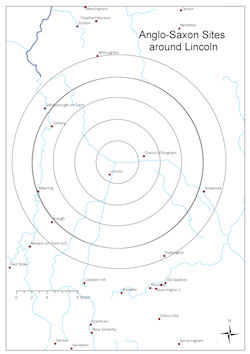
The two Lincoln sites are approximately 2.2 miles apart (Figure 12). The Roman stamp, from the Flaxengate site within the city, is on a 'Romano-Saxon' greyware bowl, which was published by Roberts as his number B36.1 (Roberts 1982, 69, fig. 20). The Anglo-Saxon pot was found unstratified (Myres 1951, 87, fig. 9-1), but Webster reported that it had been found in the flue of the kiln at Westwick Gardens (otherwise known as Rookery Lane) (Webster 1960, 214). There appears to have been another stamped sherd from the same site, which is not mentioned in either publication, but which the AASPS has recorded. The Anglo-Saxon find is of particular interest because Thomas Green believes that there was a British kingdom, which he calls *Lindes, centred around Lincoln in the 5th and 6th centuries, and which became the kingdom of Lindissi probably around AD 600. He points out that all the large cremation cemeteries of the 5th and 6th centuries were spaced out around the county in a pattern 'suggestive of each cemetery being at the centre of a defined territory, for which it presumably acted as both a central burial ground and a sacred and social focus and place of assembly'. He also notes that 'the immediate vicinities of these cemeteries ... seem to have become the centres of later political and administrative territories' (Green 2012, 61). He continues:
'The point here is, however, that these cremation cemeteries and their territories avoid Lincoln itself entirely, forming in effect a ring around the city.' (Green 2012, 62)
The Westwick Gardens/Rookery Lane site and another field-walking find of one stamped sherd from Cherry Willingham (Everson 1979) are the only sites with stamped pottery within a 10-mile radius of Lincoln known to the AASPS, before Torksey on the banks of the Trent (approximately 9.5 miles). The exact findspot(s) of the Torksey pottery is not known, but the area produced only small quantities of pottery and certainly was not a cemetery.
The two Milton Keynes sites are approximately 7 miles apart: Caldecotte is now beneath the eponymous Balancing Lake and all finds were from the topsoil. The sherd was from an Oxfordshire Ware bowl and there were also Saxon finds - the site was not excavated (Marney et al. 1989, 51-4). Pennyland was an Anglo-Saxon settlement overlying an Iron Age settlement and the shouldered pot with long bosses and this motif came from an SFB (Williams et al. 1993, 250, fig. 101-20).

The AASPS has recorded 104 examples from 31 sites for the A 5fi motif in this period, representing approximately 0.77 per cent of the whole (Figure 13). Statistical analysis (Nearest Neighbour Index and Ripley's K, see O'Sullivan and Unwin 2003) demonstrates some clustering of the A 5fi motif in the Cambridge and Lark Valley area. There are also three places where both Roman and Anglo-Saxon examples of this motif occur in reasonably close proximity (see Table 5).
| Parish | ARPS no./AASPS code | Site | County |
|---|---|---|---|
| Caistor St Edmund | 60 | Town | Norfolk |
| Caistor St Edmund | 019 CAS | Gravel pit opp. Venta Icenorum | Norfolk |
| Portchester | 305 | Castle | Hants |
| Portchester | 234 POR | Castle | Hants |
| York | 434 | Bishophill | Yorks, North |
| York | 396 | The Mount | Yorks, North |
| York | 123 YKN | The Mount | Yorks, North |
None of these three places have any obvious connection with each other, but all can be regarded as places where Roman influence was likely to linger after the official 'departure' of the Roman administration.
York, with its imperial connections from Hadrian to Constantine, its position as capital of Britannia Secunda and base for the Dux Britanniarum and his forces, must have been an administrative centre up to the departure and beyond. There are two Roman examples. Both stamps are from 'Romano-Saxon' pottery as noted above: one from Bishophill in the colonia and one from The Mount cemetery. Both sites lie on the west bank of the River Ouse, approximately 0.675 of a mile apart. The Anglo-Saxon example comes from The Mount Anglian cremation cemetery, excavated in 1859-60, which lay 'in the centre of one of York's most important burial grounds' (Stead 1958, 429). The motif occurs on a 'small biconical accessory vessel', which Myres considered to be similar (certainly in shape) to a pot from Ezinge (Myres 1948, 467, 486, fig. 6). As drawn, the motif on the Ezinge pot would appear to be an A 5a motif.
The most interesting of these sites are Caistor St Edmund and the Saxon Shore fort at Portchester, which are the only two sites in Britain where both Roman and Anglo-Saxon examples of both motifs have been found (Figure 14). Caistor St Edmund has been proposed as a possible capital of the Diocletian province of Flavia Caesariensis (Anon c. 2011), although to my mind the usual identification of Lincoln (Esmonde Cleary 1989, 47-8) is more convincing. The Roman A 5fi example is on an Oxfordshire Ware bowl from the 1929-30 excavations (Young 1977, fig. 61-C74.5a). There is only one Anglo-Saxon A 5fi example, from a sub-biconical urn (Myres and Green 1973, 199, fig. 43-Y 9), out of the 435 stamps recorded from the cremation cemetery. It is also notable that, although the A 5d motif was also found here in both periods (see above), there were no examples of either the A 5d or A 5fi motifs from the 100 stamps recorded from the adjacent Markshall Farm cremation cemetery, which was in use at more or less the same time (Myres and Green 1973, 236).
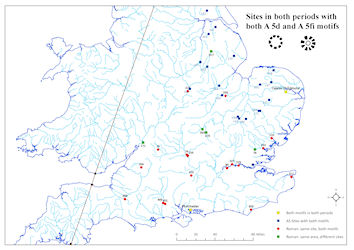
Six Roman examples of the A 5d motif were found at Portchester: two examples come from a beaker and a sherd of New Forest Ware, while the other four are from Oxfordshire Ware bowls (Cunliffe 1975, figs 169, 174, 175, 176). The Anglo-Saxon A 5d(viii) from a small sherd is illustrated without comment (Cunliffe 1970, fig. 3-10) and later as S35 (Cunliffe 1976, 141, fig. 112-158). In fact, S185 on another small sherd (Cunliffe 1976, 141, fig. 112-159) uses the same motif and is very probably from the same die. The die used on the Oxfordshire Ware bowl no. 36.9 (fig. 175) is possibly comparable. Three Roman examples of A 5fi have been found at Portchester: one on a bowl of New Forest Ware, while the other two are from Oxfordshire Ware bowls (Cunliffe 1975, figs 174, 175).The Anglo-Saxon A 5fi (on three sherds including part of the rim) is illustrated as a 'characteristic type ... made in a heavily grass-tempered fabric of local type' (Cunliffe 1970, 71-2, fig. 3-9) and again as S30 (Cunliffe 1976, 141, fig. 112-163). The die used on the Oxfordshire Ware bowl no. 34.5 (fig. 174) is possibly comparable.
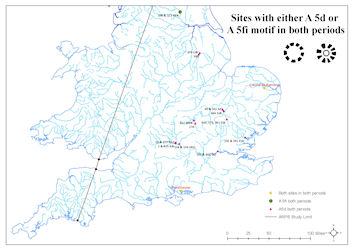
It is an interesting exercise to compare the distributions of these two motifs in the Roman and post-Roman periods (Figure 15). I should note that my sectors are not precise quarters of modern-day England and Wales, but rather represent what appear to be areas of influence during the two periods (Figure 16). My north-east sector turns out to be very close in scope to John Blair's 'Anglo-Saxon building culture province', although we have arrived at those areas completely independently (Blair 2014, 15, fig. on page 22). The contrast between the two periods is stark and leads to the conclusion that, except on a site where the motif has been found from both periods, it is unlikely that the 4th-century Roman tradition influenced the Anglo-Saxon potters in any way. Looking at the distribution by county gives more detail, but does not change the overall results (Figure 17).
